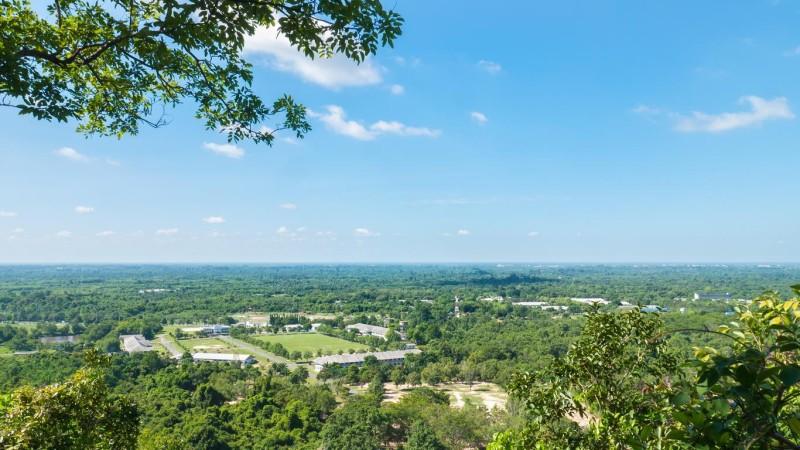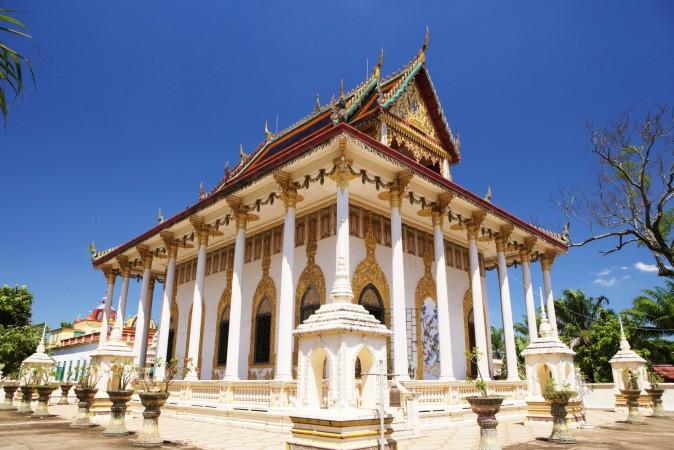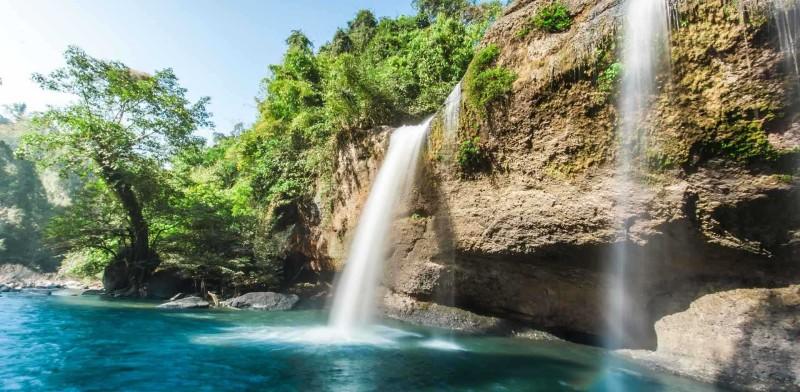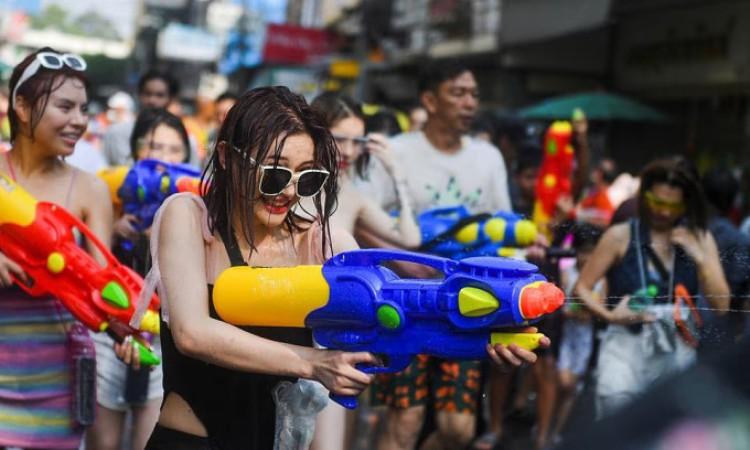Explore Prachin Buri - Thailand Travel, Asia
Prachin Buri, a charming province in Eastern Thailand, is a destination that invites exploration beyond the usual tourist trail. This hidden jewel, steeped in history and surrounded by lush surroundings, provides the ideal balance of cultural depth and natural beauty. Whether you're an explorer looking for outdoor thrills or a visitor wanting to immerse oneself in true Thai culture, Prachin Buri with its serene temples, vibrant festivals, and mouth-watering cuisine, is a destination worth discovering.
Population: Approximately 500,000 in 2018.
Economy: Prachin Buri's economy is diverse, focusing on agriculture, including rice and fruit cultivation, as well as tourism, which highlights its cultural sites and natural attractions.
Landmarks: Famous for the Khao Yai National Park, Wat Kaeo Phichit, and Museum of Phanom Rung.
Thailand

Overview of Prachin Buri
History & Culture Influence
Prachin Buri is a province where history whispers through ancient ruins and the walls of venerable temples. The influence of Buddhism is evident everywhere, from the ornate carvings at Wat Kaeo Phichit to the serene atmosphere that envelops the province. The area’s historical significance is further highlighted by its connection to King Taksin the Great, who is believed to have passed through Prachin Buri during his efforts to unify Thailand. The local culture, deeply rooted in these historical events, is reflected in the residents' daily lives and their unwavering dedication to preserving traditional customs.
Interaction with The Locals
Prachin Buri is home to a population of approximately 500,000 people, who embody the warm and hospitable spirit typical of Thai culture. The residents, primarily of Thai descent, maintain strong ties to their cultural heritage, with a deep respect for traditions and Buddhism playing a central role in their daily lives. The local community is known for its friendliness, often welcoming visitors with open arms and a genuine interest in sharing their way of life.

Elephants in Khao Yai National Park - © Thai National Parks
Top Attractions in Prachin Buri
These top attractions highlight the diverse experiences Prachin Buri offers, from natural wonders to historical treasures, ensuring a rich and varied exploration of this captivating province.
Khao Yai National Park
A crown jewel of Prachin Buri, Khao Yai National Park is a UNESCO World Heritage site known for its stunning natural beauty. Spanning lush forests, waterfalls, and expansive grasslands, the park is a haven for outdoor enthusiasts. Visitors can hike through diverse landscapes, spot exotic wildlife, and enjoy bird-watching in one of Thailand’s most famous nature reserves. Whether you're exploring the park's scenic trails or marveling at its diverse flora and fauna, Khao Yai offers a memorable escape into nature.
Wat Kaeo Phichit
Wat Kaeo Phichit is a historical gem that reflects the deep spiritual roots of Prachin Buri. This temple is renowned for its intricate architecture, which combines traditional Thai design with influences from neighboring cultures. The peaceful atmosphere here provides a perfect setting for meditation and reflection, while the beautifully preserved murals and statues offer insights into the region's rich cultural heritage. A visit to Wat Kaeo Phichit is a journey into the spiritual heart of Prachin Buri, where history and devotion converge.
Museum of Phanom Rung
Step back in time at the Museum of Phanom Rung, where the ancient Khmer temple complex stands as a testament to the region's historical significance. The well-preserved ruins and detailed carvings at this site showcase the architectural brilliance of the Khmer Empire. Visitors can explore the temple's remnants and learn about the cultural and religious influences that shaped the region. The museum provides context and history, making it a must-visit site for those interested in the ancient civilizations of Southeast Asia.

Wat Kaeo Phichit - © Museum Thailand
Must-Try Dishes in Prachin Buri
Prachin Buri's culinary tradition is a flavorful journey through traditional Thai cuisine, infused with unique local ingredients and cooking methods.
- Gaeng Pa (Jungle Curry): Unlike other Thai curries, Gaeng Pa, or Jungle Curry, is made without coconut milk, resulting in a lighter yet intensely spicy dish. Traditionally prepared with wild meats, this curry is packed with fresh herbs and vegetables.
- Yum Naem Kao Tod (Crispy Rice Salad): Yum Naem Kao Tod is a refreshing and zesty salad made from crispy rice, fermented sausage, fresh herbs, and a tangy lime dressing. This dish offers a perfect balance of textures and flavors, making it a popular choice among locals and visitors alike.
- Pad Mee Prachin Buri (Prachin Buri Fried Noodles): A local twist on the classic Thai stir-fried noodle dish, Pad Mee Prachin Buri features rice noodles stir-fried with a mix of vegetables, tofu, and sometimes shrimp or pork. The dish is seasoned with soy sauce, garlic, and a touch of sweetness, resulting in a savory and satisfying meal.
- Hor Mok Pla (Steamed Fish Custard): Hor Mok Pla is a traditional Thai dish where fish is steamed in a rich, spiced coconut milk custard. Wrapped in banana leaves, this dish is not only flavorful but also visually appealing, together with the combination of the creamy custard with the tender fish creates a delightful contrast.
- Sai Krok Isan (Isan Sausage): Though originally from the Isan region, Sai Krok Isan is a popular street food in Prachin Buri. This fermented sausage is made from pork, rice, and garlic, giving it a distinctive sour taste. It’s typically grilled and served with fresh vegetables, making it a perfect snack or appetizer.
- Pla Duk Tod Kamin (Fried Catfish with Turmeric): Pla Duk Tod Kamin is a dish where catfish is marinated with turmeric and deep-fried until crispy. The turmeric not only gives the fish a vibrant color but also adds a unique earthy flavor.

Yum Naem Kao Tod - © Cook Eat World
Festivals & Local Celebrations
Festivals in Prachin Buri are vibrant expressions of the province's cultural and spiritual life. These events offer visitors a chance to experience the traditions and joy that are an integral part of local life.
Songkran Festival
The Songkran Festival, celebrated in mid-April, is the Thai New Year and one of the most important festivals in Prachin Buri. This event is marked by traditional water-splashing activities, parades, and religious ceremonies. It’s a time when locals come together to pay respect to their elders, make merit, and celebrate with family and friends. Visitors can join in the festivities, experiencing the unique blend of fun and tradition that defines Songkran.
Phanom Rung Festival
Held annually at the ancient Khmer temple complex, the Phanom Rung Festival is a celebration of the historical and cultural heritage of Prachin Buri. The event features traditional dance performances, light and sound shows, and a re-enactment of ancient rituals. This festival is a spectacular way to immerse yourself in the region’s history while enjoying the vibrant atmosphere.

Phanom Rung Festival - © Matador Network
What to Do in Prachin Buri
Prachin Buri offers a wide range of activities for visitors, catering to both adventure seekers and those looking for a more relaxed experience.
- Hiking in Prachin Buri: With its rich natural landscapes, Prachin Buri is a paradise for outdoor enthusiasts. Khao Yai National Park is a prime destination for hiking, offering trails that lead through dense forests, past waterfalls, and into areas where you can spot elephants, gibbons, and various bird species.
- Temple Tours in Prachin Buri: For those interested in history and culture, Prachin Buri’s many temples offer a fascinating glimpse into the spiritual life of the region. A tour around Wat Kaeo Phichit and other local temples allows visitors to admire traditional Thai architecture, learn about Buddhist practices, and enjoy the peaceful ambiance that pervades these sacred spaces.
- River Rafting: For a more adventurous experience, river rafting on the Prachin Buri River is a thrilling way to explore the area’s natural beauty. This activity combines excitement with the opportunity to see the region from a different perspective, passing through lush forests and rural landscapes.
Shopping in Prachin Buri
- Prachin Buri Night Market: This lively market is a must-visit for anyone looking to experience the local culture. Open in the evenings, the Prachin Buri Night Market offers a wide array of street food, fresh produce, clothing, and accessories. It’s a great spot to mingle with locals and find unique, affordable souvenirs.
- Wat Bot Market: Located near Wat Bot Temple, this market is famous for its fresh, locally-grown produce and traditional Thai snacks. The Wat Bot Market is an excellent place to pick up seasonal fruits, vegetables, and regional specialties that you can enjoy on the go or take home.
- Ban Dong Bang Handicrafts Center: The Ban Dong Bang Handicrafts Center is known for its intricate bamboo and rattan products. Visitors can shop for baskets, mats, and various home decor items, all made by local artisans using traditional methods passed down through generations.

Hiking in Khao Yai National Park to witness Prachin Buri's natural beauty - © Thailand Tourism
Weather in Prachin Buri: Best Time to Visit
Prachin Buri’s tropical climate offers three distinct seasons, each bringing its own charm and influencing tourism trends. Understanding the weather conditions will help you plan the best time to visit, ensuring a memorable experience tailored to your preferences.
Hot Season in Prachin Buri
During the hot season, temperatures often exceed 35°C (95°F), making it ideal for those who enjoy sun-soaked adventures. This period sees fewer tourists, offering a quieter, more relaxed experience. Popular activities include exploring ancient ruins early in the morning or enjoying the region’s natural beauty by the rivers and waterfalls. However, due to the heat, this season is less busy, and you might find lower prices on accommodations and tours.
Rainy Season in Prachin Buri
The rainy season is marked by heavy afternoon showers, transforming Prachin Buri into a lush, green paradise. Nature lovers flock to the region during this time to witness its vibrant flora and fauna. The rain brings out the beauty of waterfalls and national parks, making it a popular time for eco-tourism and photography enthusiasts. Despite the rain, many tourists are drawn by the lower rates and the opportunity to experience the natural environment at its most vibrant.
Cool Season in Prachin Buri
The cool season is Prachin Buri’s peak tourist period, with temperatures ranging from 20°C to 30°C (68°F to 86°F). The pleasant weather makes it ideal for all types of outdoor activities, from exploring historical sites to hiking in national parks. The cool, dry conditions are perfect for festivals and cultural events, drawing the highest number of visitors. During this season, expect more crowded attractions and higher prices, but also a vibrant atmosphere with many events and festivals.

Experience Prachin Buri's Songkran Festival - © VnExpress International
Essential Travel Information
Getting Around Prachin Buri
- Motorbikes and Bicycles: For those who prefer independence and flexibility, motorbike or bicycle is a popular choice, providing an easy way to explore both urban and rural areas at your own pace.
- Songthaews: Songthaews, shared pickup trucks with benches, are a common form of public transport in Prachin Buri, offering an affordable and authentic way to get around town.
- Tuk-tuks: The iconic three-wheeled vehicles are also available for shorter trips or when you want a more unique travel experience.
- Taxis and Private Cars: For comfort and convenience, taxis and private car services are available, especially for longer journeys or trips to specific attractions. Booking a private car with a driver can be arranged through your accommodation or a local travel agency, ensuring a hassle-free experience.
ATM & Banking Services
In Prachin Buri, accessing financial services is straightforward with numerous ATMs and banking options available throughout the region. ATMs are widely distributed in urban areas and near popular tourist sites, accepting major international cards for convenient cash withdrawals. While ATMs provide quick access to cash, visiting a bank or authorized exchange bureau is recommended for the best currency exchange rates and more specialized financial services.
Where to Stay in Prachin Buri
- Luxury Resorts: For those seeking an upscale experience, luxury resorts in Prachin Buri provide premium amenities such as swimming pools, spa services, and fine dining. These resorts are often located in picturesque settings, offering stunning views and a high level of comfort for a truly indulgent stay.
- Boutique Hotels: Boutique hotels in Prachin Buri offer a more personalized experience with unique decor and a cozy atmosphere. These accommodations typically reflect local culture and provide attentive service, making them a charming choice for travelers looking for a distinctive and comfortable stay.
- Guesthouses: Budget-conscious travelers will find a variety of guesthouses and budget hotels that offer affordable yet comfortable lodging. These options are ideal for those who want to save on accommodation costs while still enjoying a clean and welcoming environment, often with essential amenities to ensure a pleasant stay.
- Homestays: Homestays allow tourists to stay with local families, giving them a better understanding of the region's culture and lifestyle. These accommodations often include meals and personalized tours or activities, giving travelers a unique and memorable experience while supporting local communities.
Articles for you

Explore Yala National Park - Sri Lanka Travel, Asia
Tucked away in Sri Lanka’s southeastern corner, Yala National Park is where wild nature meets deep tradition. Known worldwide for its leopard population, the park is also home to elephants, sloth bears, crocodiles, and hundreds of bird species. Beyond wildlife, Yala opens doors to a cultural landscape dotted with ancient temples, Buddhist ruins, and coastal villages. For travelers seeking more than just a safari, Yala offers a chance to explore eco-tourism, local communities, and sacred heritage sites.
Population: The Yala National Park area doesn’t have a human population.
Economy: The economy around Yala National Park thrives on a blend of eco-tourism, agriculture, and local services. Safari tours, eco-lodges, and cultural experiences drive steady income for nearby towns like Tissamaharama and Kataragama, supporting thousands of families.
Landmarks: Famous for Block I of Yala and wildlife encounters, including elephants, sloth bears, crocodiles, and exotic bird species.

Explore Galle - Sri Lanka Travel, Asia
Nestled on Sri Lanka’s southern coastline, Galle is a vibrant city where history meets the sea. Its cobbled streets, colonial architecture, and serene beaches make it a must-visit destination for travelers seeking a blend of culture, adventure, and relaxation. A UNESCO World Heritage site, Galle captivates visitors with its Dutch Fort, bustling markets, and friendly locals. Whether you’re exploring the ramparts at sunset or savoring fresh seafood by the shore, Galle promises an unforgettable journey into Sri Lanka’s heritage.
Population: Approximately 113,000 in 2023.
Economy: Galle’s economy thrives on tourism, trade, and fisheries. The city’s historic fort, colonial architecture, and coastal charm draw thousands of international visitors each year, making tourism its main economic driver. Fishing remains vital for local livelihoods, supplying fresh seafood across the region.
Landmarks: Famous for the Galle Fort, Dutch Reformed Church & Maritime Museum, and Unawatuna Beach.

Explore Bentota - Sri Lanka Travel, Asia
Nestled along Sri Lanka’s southwestern coast, Bentota is a tropical paradise that blends golden beaches, vibrant culture, and thrilling adventures. Famous for its calm waters, luxury resorts, and scenic river estuary, Bentota has become a top destination for travelers seeking both relaxation and authentic experiences. From serene beach walks at sunrise to adrenaline-pumping water sports, this coastal town offers a perfect balance of leisure and exploration. With its proximity to Colombo and Galle, Bentota is easy to reach, making it an ideal stop for both short escapes and extended holidays.
Population: Approximately 37,000 in 2023.
Economy: Bentota’s economy thrives mainly on tourism, which drives local businesses such as hotels, restaurants, and wellness retreats. The town also benefits from fishing, coconut cultivation, and handicrafts like wood carving and batik textiles. Many residents rely on the growing demand for water sports and Ayurvedic treatments, making tourism the backbone of both income and employment in the area.
Landmarks: Famous for Bentota Beach, Bentota River Safari, and Kande Vihara Temple.

Explore Mirissa - Sri Lanka Travel, Asia
Mirissa is a charming coastal town on Sri Lanka’s southern shoreline. Known for its golden beaches, turquoise waters, and vibrant marine life, it has become a must-visit stop for travelers exploring the island. Many come for whale watching, surfing, and sunset views at Coconut Tree Hill, but Mirissa offers much more than postcard beauty. The fishing boats you see anchored by the bay carry generations of stories. Local traditions, delicious cuisine, and a laid-back rhythm of life shape every visitor’s experience.
Population: Approximately 4,700 in 2023.
Economy: Mirissa’s economy is largely shaped by its coastal location. Fishing has long been the backbone of local livelihoods, with generations relying on the Indian Ocean for income. In recent decades, tourism has become the main driver of growth, thanks to whale watching, surfing, and beachside hospitality.
Landmarks: Famous for Mirissa Beach, Coconut Tree Hill, and Parrot Rock Bridge.

Explore Nuwara Eliya - Sri Lanka Travel, Asia
Tucked away in the Central Highlands of Sri Lanka, Nuwara Eliya is often called “Little England”. With its rolling tea plantations, cool misty mornings, and colonial charm, this mountain town feels like a step into another world. Travelers come here to breathe fresh air, walk through flower gardens, sip the finest Ceylon Tea, and enjoy a pace of life far from the island’s busy cities. Whether you’re drawn by scenic landscapes, heritage architecture, or the warmth of its people, Nuwara Eliya is a destination that blends nature, culture, and history in perfect harmony.
Population: Approximately 781,000 in 2023.
Economy: Nuwara Eliya’s economy thrives mainly on tea production, as it sits in the heart of Sri Lanka’s central highlands, famous worldwide for Ceylon Tea. The city also benefits from a growing tourism industry, attracting visitors with its colonial charm, cool climate, and scenic landscapes.
Landmarks: Famous for Gregory Lake, Hakgala Botanical Garden, and Victoria Park.

Explore Sukau - Malaysia Travel, Asia
Nestled on the banks of the Kinabatangan River in Sabah, Malaysian Borneo, Sukau is a destination where wildlife, culture, and conservation come together. Known as one of Asia’s top spots for river safaris and eco-tourism, this quiet village offers a front-row seat to encounters with Bornean orangutans, pygmy elephants, proboscis monkeys, and exotic birdlife.
Population: Approximately 1,400 in 2019.
Economy: Sukau’s economy is shaped by its riverine location and natural resources. Traditionally, the Orang Sungai community relied on fishing, small-scale farming, and forest gathering for their livelihood. Today, the village has shifted toward eco-tourism, with river cruises, jungle trekking, and homestays providing income.
Landmarks: Famous for the Kinabatangan River cruises, Gomantong Caves, and Ox-bow lakes and wetlands.
